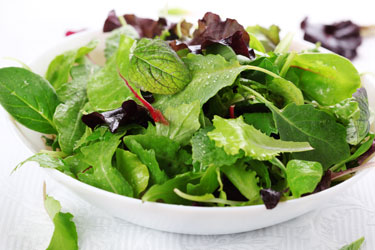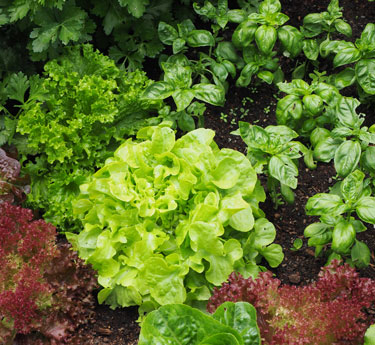Salad days
20 ways to get the best from summer greens
A salad picked fresh from the garden tastes better and is better for you. For beginner gardeners and those with limited space, green leafy salad vegetables are the way to go!
| 1 | Choose a warm sheltered spot. Sun is important but during summer your lettuces will thank you for a little afternoon shade. |
| 2 | Avoid cold wet soil. This is easily overcome by planting in raised beds or containers. |
| 3 | If planting in containers, choose the best quality planting mix you can afford and resist the temptation to recycle last years potting mix. Alternatively, fill large containers or raised garden beds with top quality compost. |
| 4 | If planting in garden beds, dig in plenty of compost to improve soil drainage and nutrient holding capacity. |
| 5 | A constant even supply of moisture is needed for rapid healthy growth. The faster your lettuces grow, the better they’ll taste. If water is limiting, slow or erratic growth can result in bitter tasting leaves or plants that bolt to seed. |
| 6 | Mulch with straw to conserve moisture and block weed growth. |
| 7 | Water in the early morning to avoid damp conditions overnight (which can invite disease). Watering in the hottest part of the day isn’t ideal as much of the water is lost to evaporation. |
| 8 | Lettuces thrive with a fertiliser high in nitrogen but they need other nutrients too. Apply general garden fertiliser two weeks after planting, or feed once a week with liquid fertiliser. For lettuces in pots, combine slow release fertiliser with liquid feeding. |
| 9 | When goring lettuces in garden beds, especially those that have been cropped for a long time, mixing garden lime into the soil prior to planting helps correct the soil pH and improve the plant ability to absorb nutrients. |
| 10 | Grow a wide range of varieties and try out something new each season so your salads need never be boring. The greener the leaf, the more vitamins and minerals it will contain! Don’t forget to plant some colours for your salads. Include red lettuce varieties, young beetroot leaves with bright red veins and edible flowers such as yellow calendula, blue borage and bright orange nasturtium. |
| 11 | For quick greens that are ready to pick in three to four weeks plant loose-leaf (‘cut and come again’) varieties, so you can take the outer leaves as plants grow. Plant some of the solid heart type of lettuce (such as ‘Iceberg’) to enjoy the satisfaction of harvesting a whole plant six to eight weeks after planting. |
| 12 | Mediterranean origin ‘Cos’ or ‘Romaine’ lettuces combine the crunchy juiciness of an iceberg lettuce with the nutritional value of a dark green leaf lettuce. Plus they are tolerant of hot summer conditions. ‘Little Gem’ is a compact form of ‘Cos’ ideal for container growing. |
| 13 | Growing lettuces from seed expands the choice of interesting varieties you can grow, but ready grown seedlings are a godsend this close to Christmas. |
| 14 | For a continuous supply all summer and autumn plant a fresh punnet of salad greens every weekend or two. Or sow some seed the day you plant your seedlings. |
| 15 | Don’t forget to apply slug bait, especially in rainy weather conditions. Voracious pests can make fast work of freshly planted seedlings. |
| 16 | Regular harvesting of young leaves promotes continuous growth of loose-leaf lettuces. The hearting varieties should be cut as soon as the hearts are firm, ideally in the morning when plants are most crisp. |
| 17 | For the best nutrition and flavour pick leaves fresh for each meal rather than storing them in the fridge. |
| 18 | If your plants turn to seed in hot weather don’t despair. If you have enough space to leave them you can enjoy the interesting shapes, and the flowers that attract beneficial insects. Or collect your own seed to sow next season. |
| 19 | Sow seed directly into warm friable garden soil, or in trays of seed raising mix for planting out later (this is a good way to keep tiny seedlings free of weeds). Lettuce seed is tiny so it barely needs covering, but sprinkle a fine layer of finely sieved soil or seed raising mix before watering gently with the watering can. Keep the soil just moist until seeds germinated (7 to 10 days). Thin out seedlings to leave the strongest - eat the thinning as micro-greens! |
| 20 | Feed seedlings with liquid seaweed to reduce transplanting shock and promote strong root growth. |
2-Nov-2017

Salad greens

Mixed lettuce and basil in the garden

Mixed lettuce in pots


